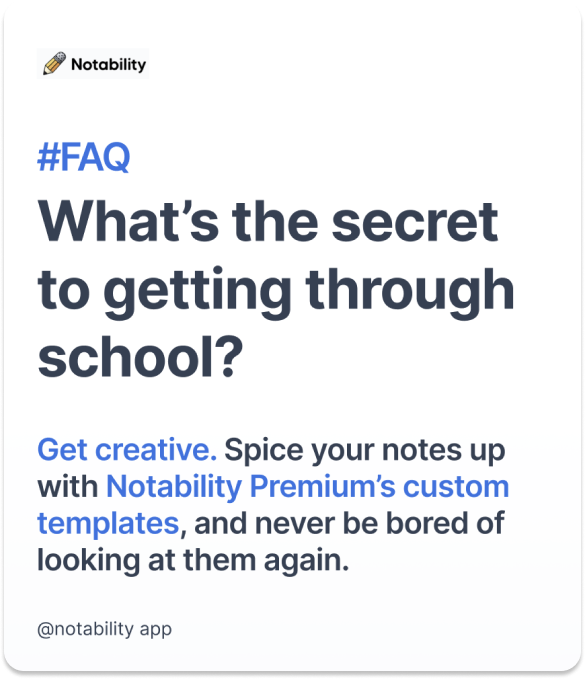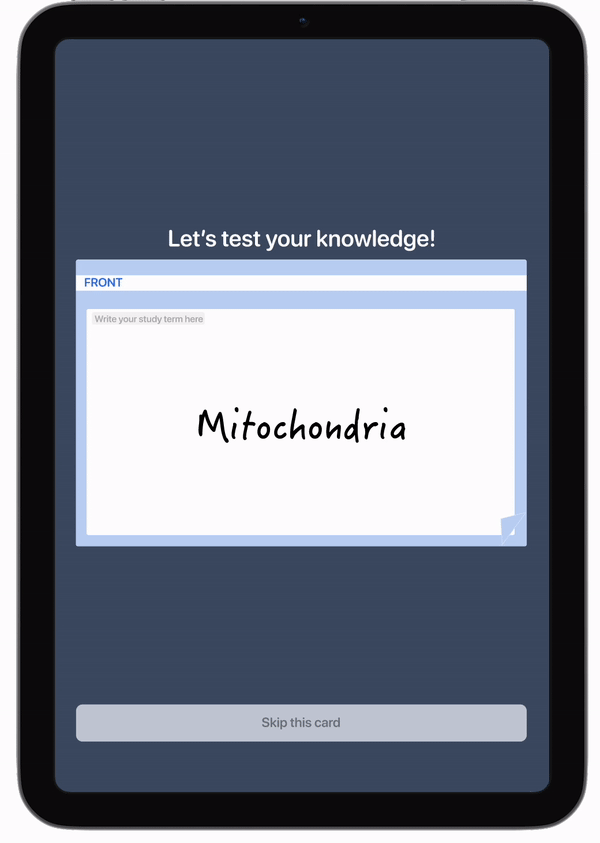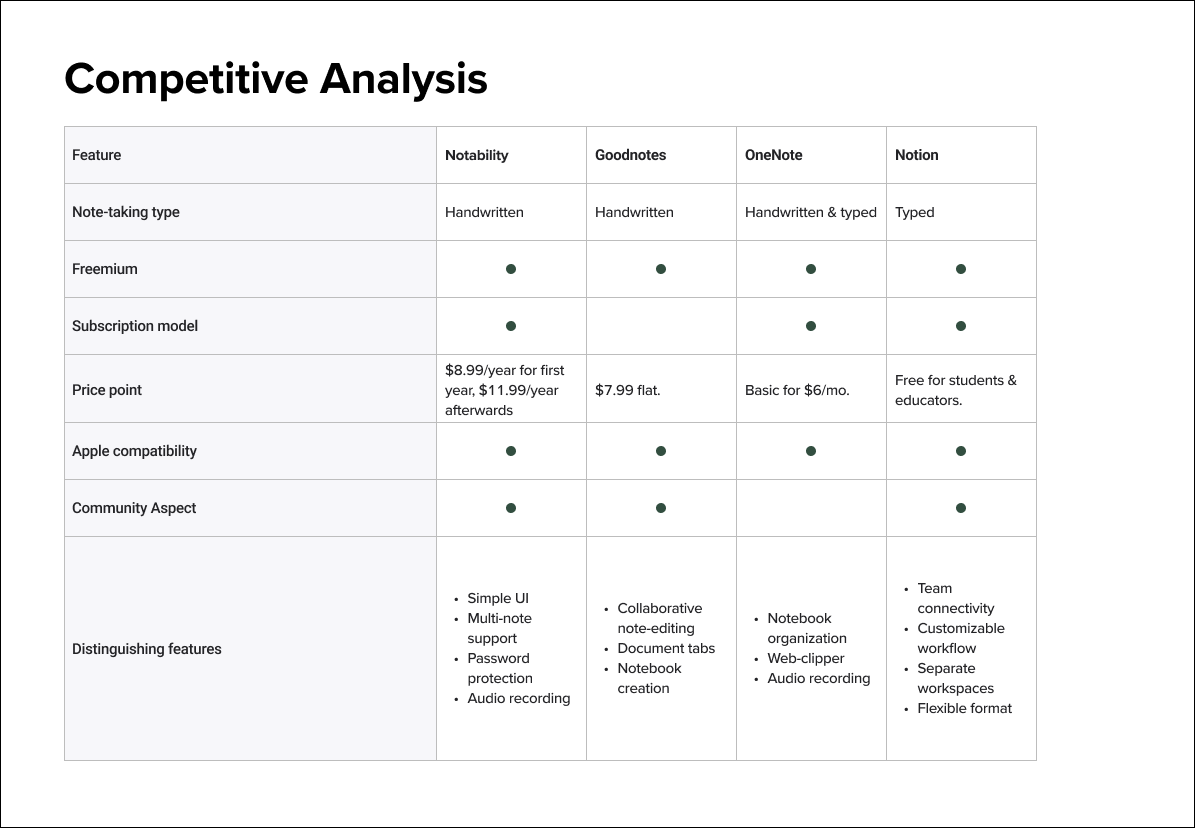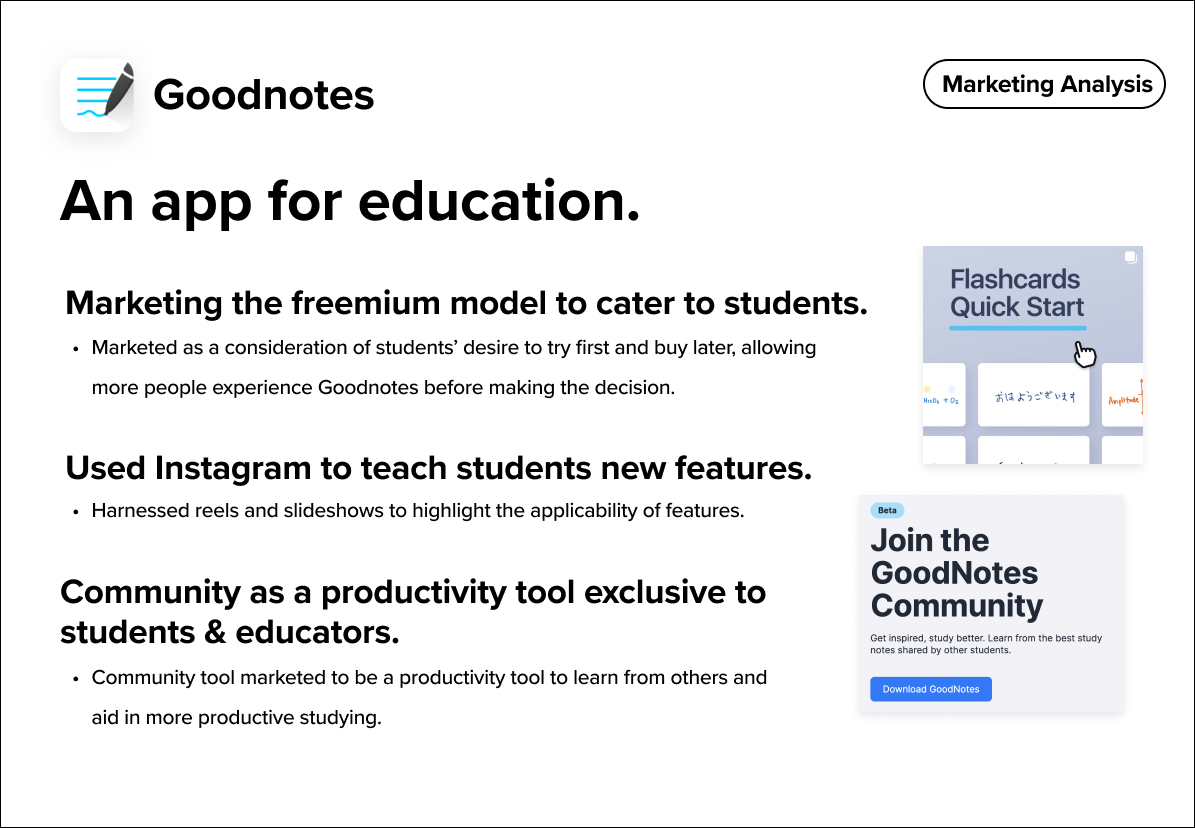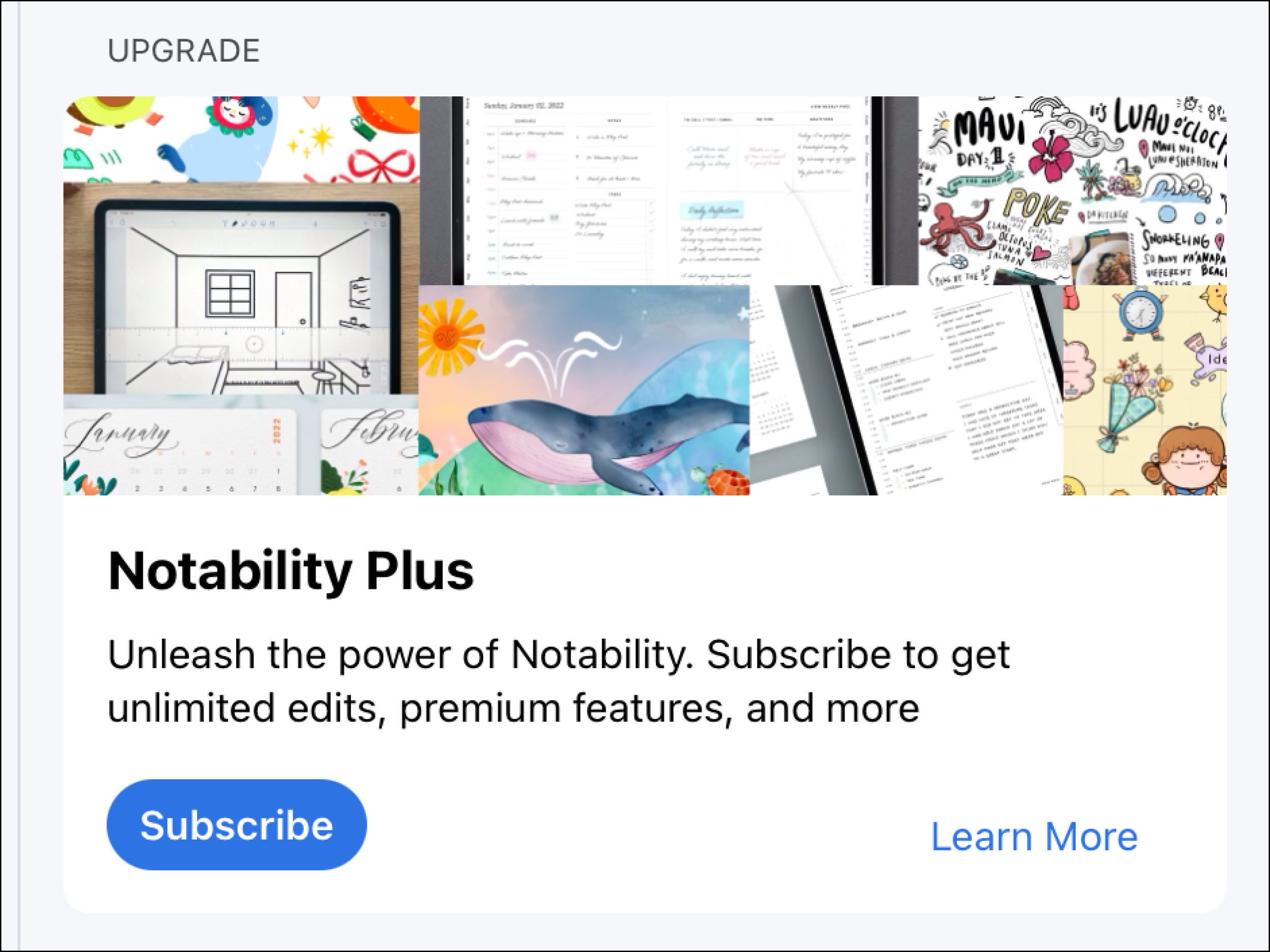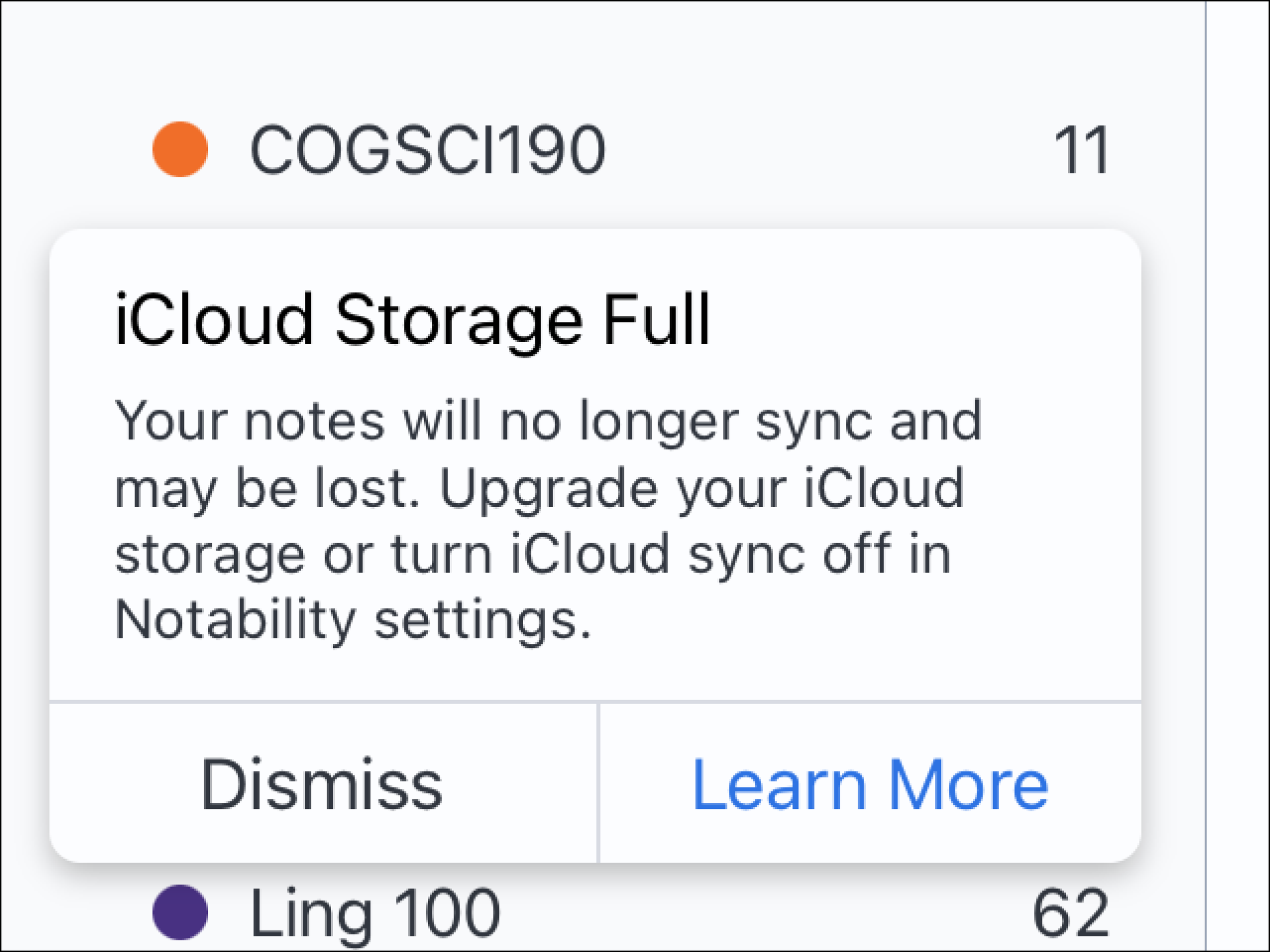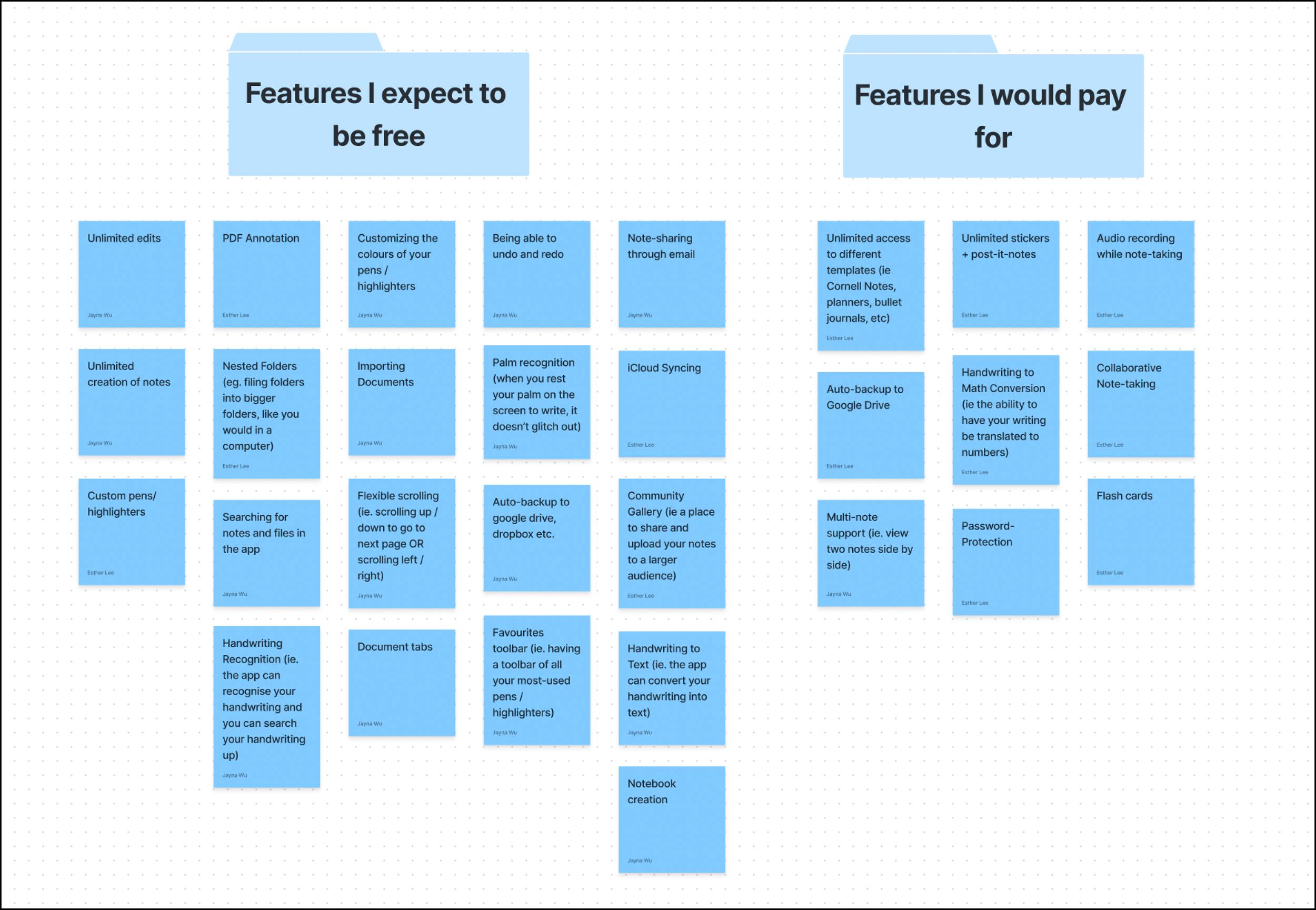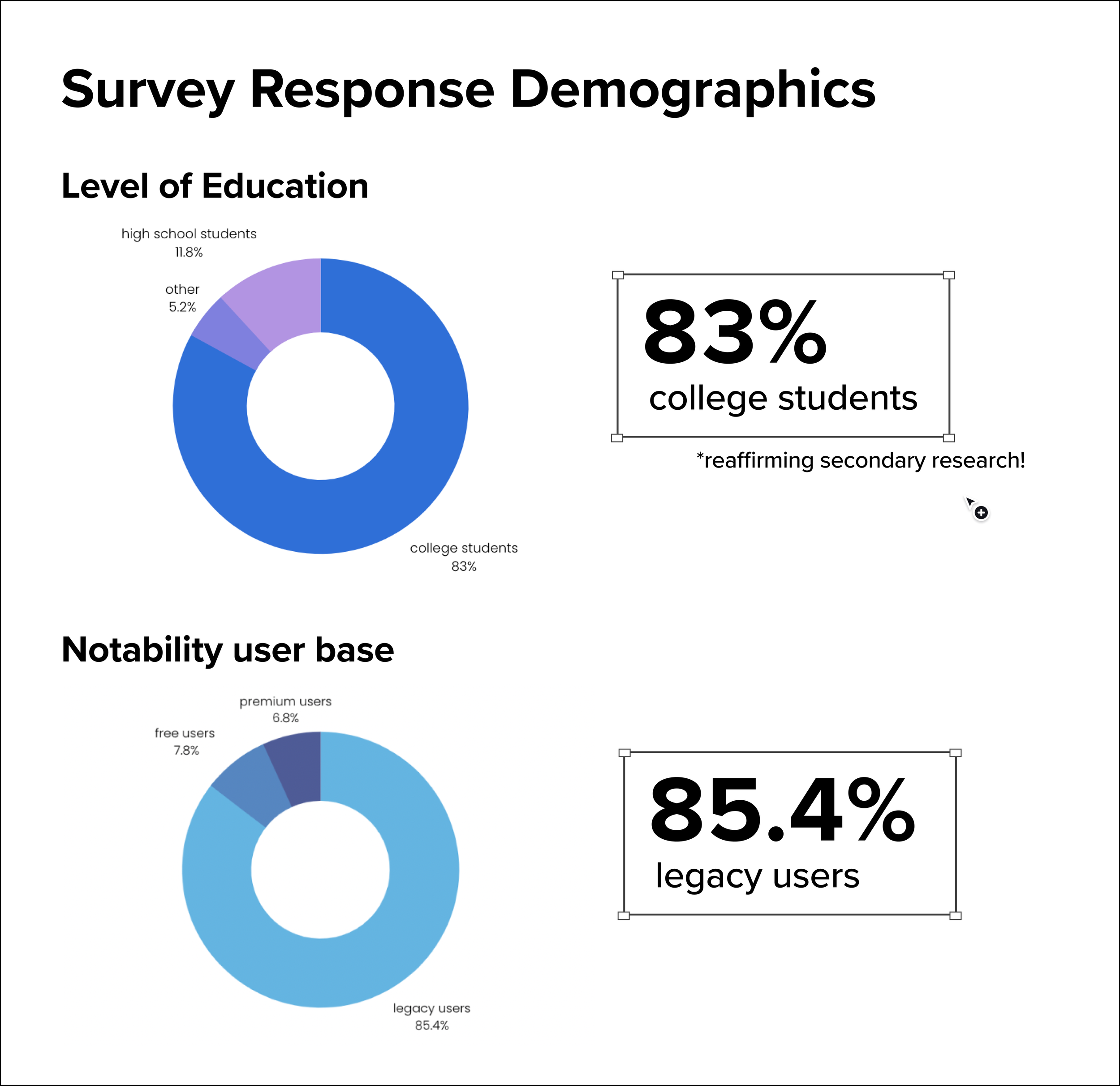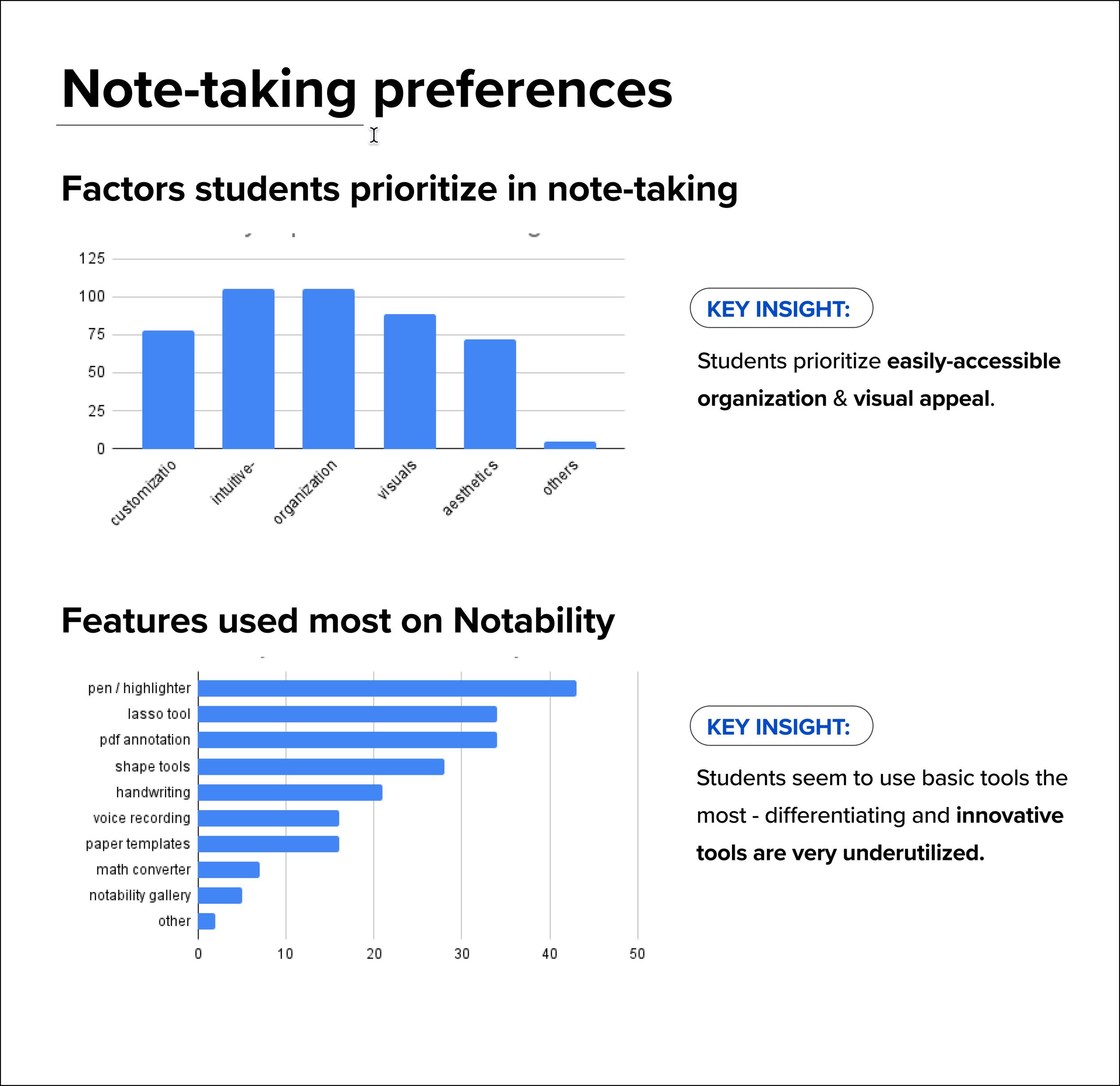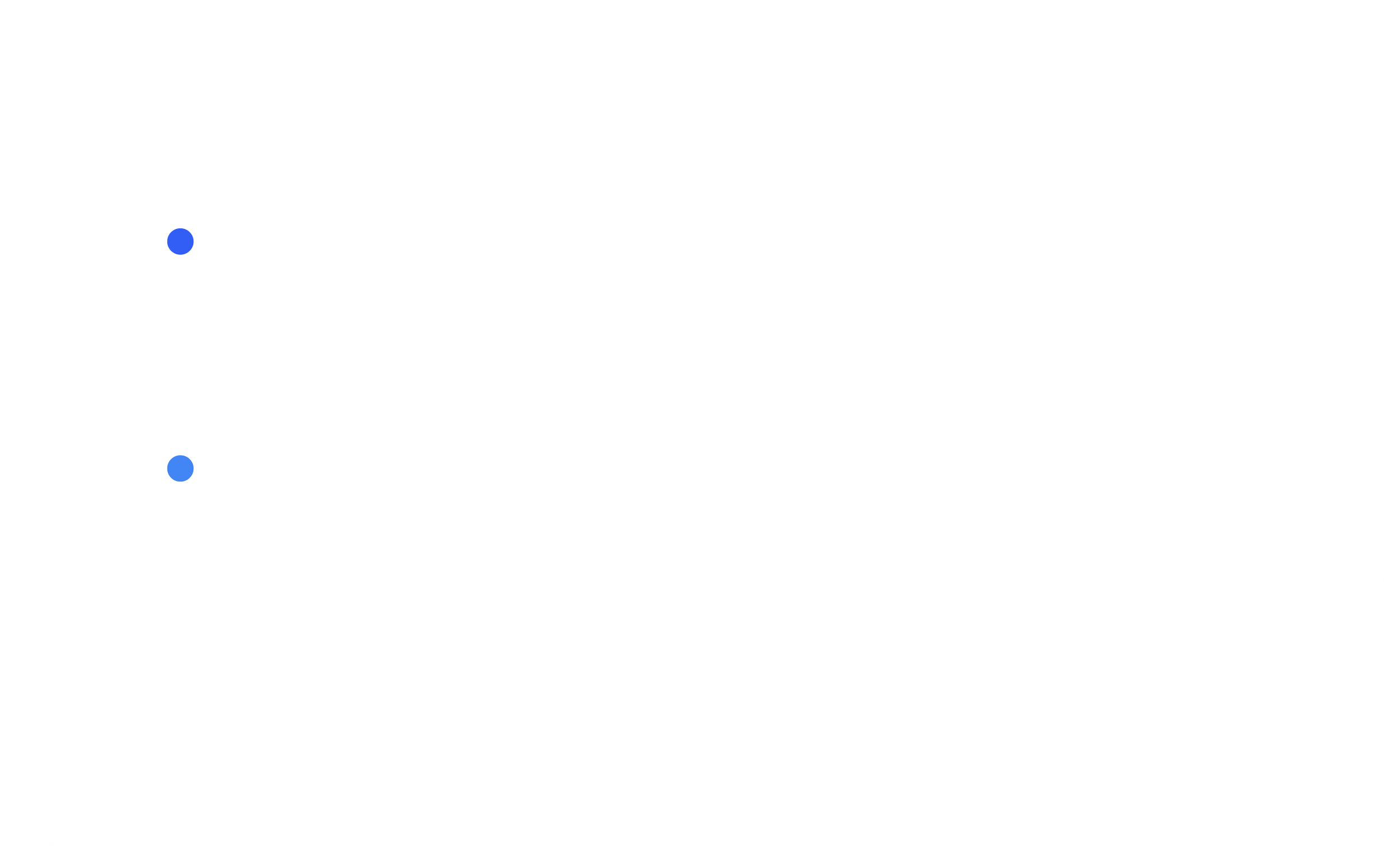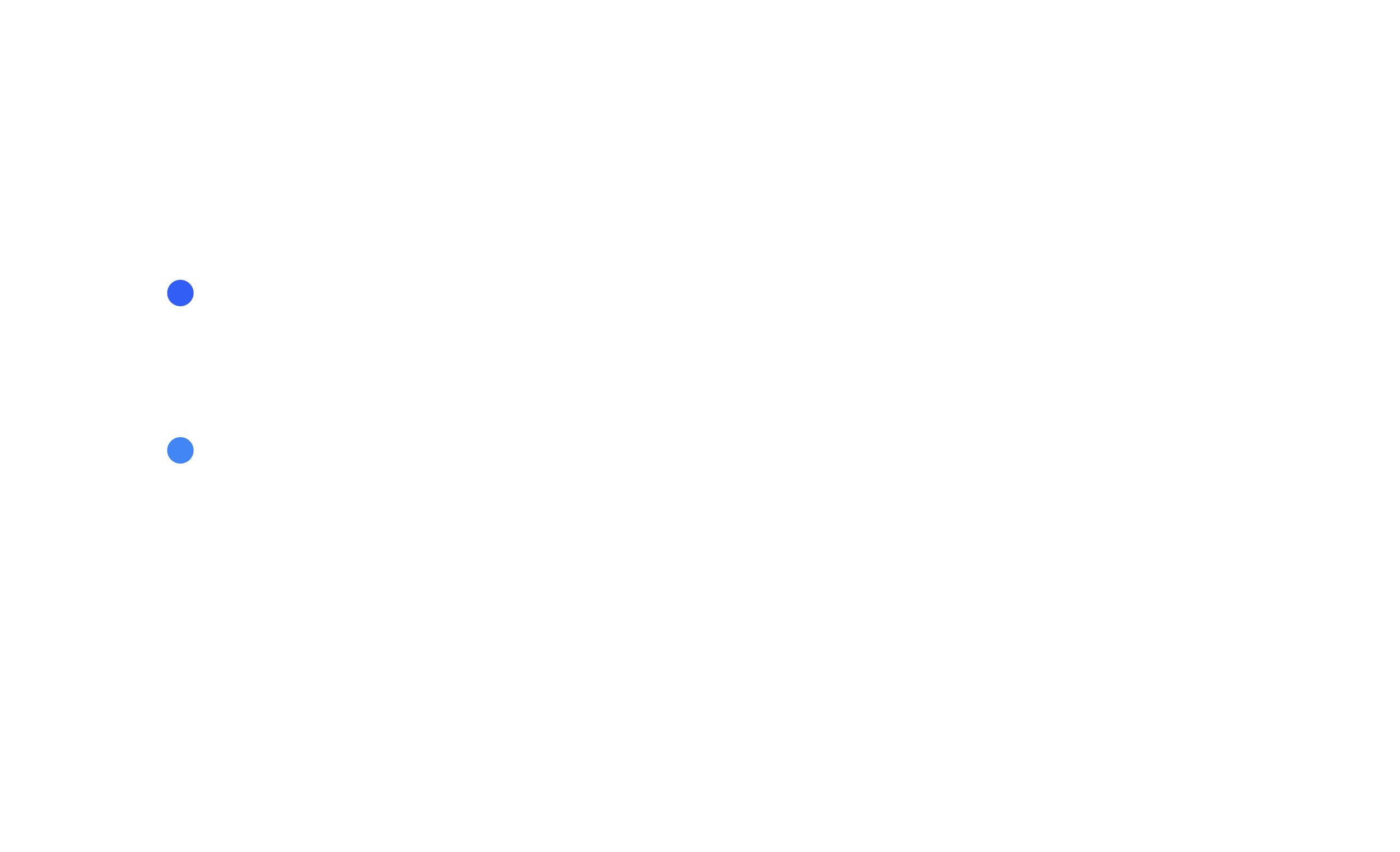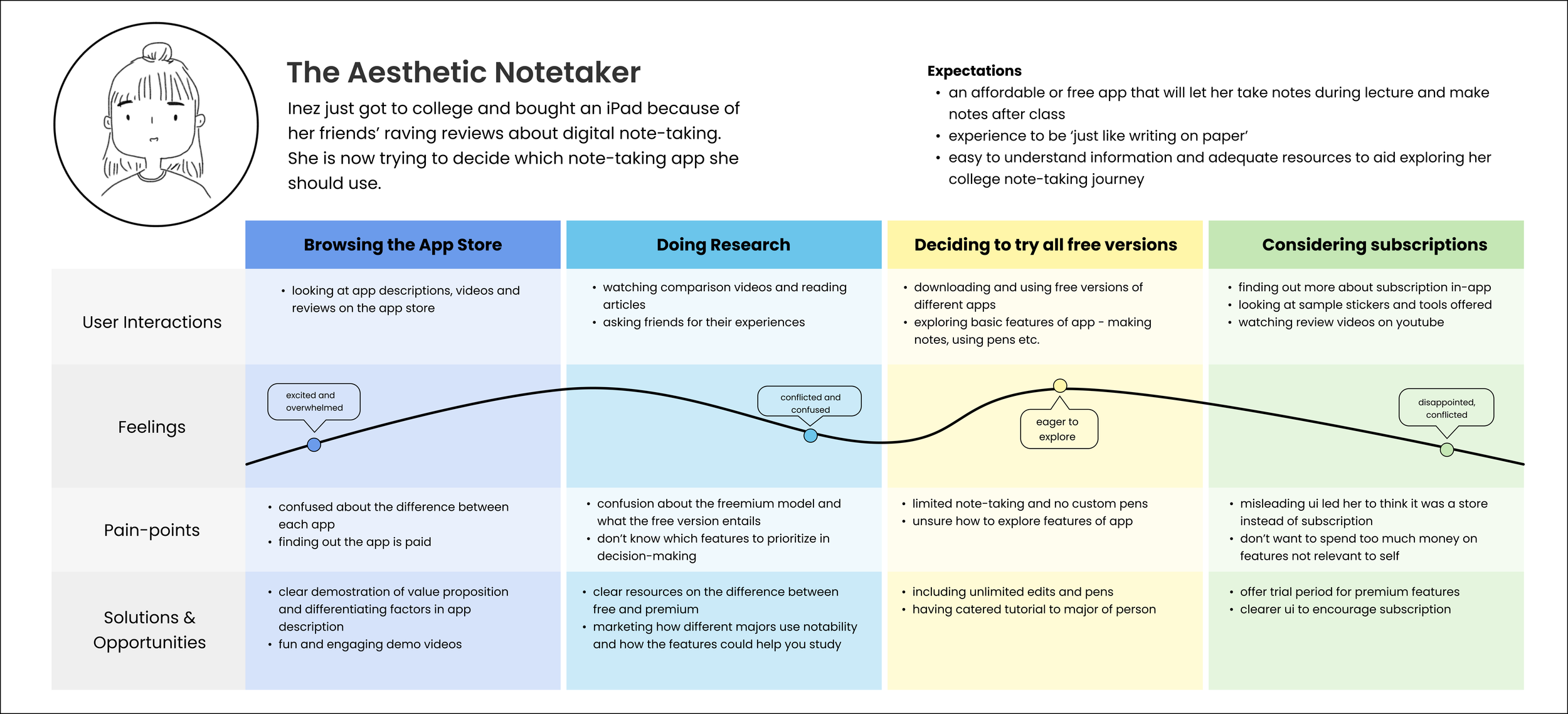
UX Research Project | Through Berkeley Innovation
Understanding user conversion to Notability’s freemium model.
Timeline
Spring 2022, 12 weeks
Team
Jayna Wu, Esther Lee, Amal Alyousfi, Zahra Baxhi
Role
Research Synthesis Sprint Lead
Tools + Craft
Competitive Analysis, Qualitative & Quantitative Surveys, User Interviews, Usability Testing, Card Sorting, Affinity Mapping, Persona and Journey Map Creation, Product Strategy
PROJECT OVERVIEW
PROBLEM SCOPE
MY ROLE
KEY CONCLUSIONS
In November 2021, Notability made the switch to a free app with the option of yearly premium subscription plan. Understandably, many loyal and new users alike expressed frustration over this change.
In collaboration with Notability, our team at Berkeley Innovation aimed to unearth the different user groups’ motivations, note-taking habits and pain-points and use this as the foundation to create a more incentivizing premium version for them.
Over the course of 12 weeks, I worked proactively with my team to practice various UX research methods, create personas and journey maps, run team and client meetings, and craft cohesive presentations for presentation to Notability’s stakeholders!
As the research synthesis sprint leader, I led the synthesis of >180 surveys, and the crafting, execution and synthesis of 12 interviews and user tests, and 10 card sorting exercises.
Price-to-value evaluation.
We found that students evaluate the price of the product against the unique value it brings to their everyday lives, and are sensitive to the emergence of alternatives that may more economically fulfill their needs.
Self discovery and experimentation.
Students also value being able to personally discover and experiment with the product before committing to a subscription, and found this lacking in their interactions with Notability.
PROBLEM STATEMENT
How might we better understand different user groups and their pain points to increase the conversion of free and legacy users to Notability premium subscribers?
OUR FINAL SOLUTIONS
Including different features that cater to different learning styles.
Currently, the premium Notability subscription focusses heavily on note-taking. However, we found that for budget-conscious students to be willing to subscribe, they would like the app’s functionalities to be upgraded beyond note-taking.
We thus envisioned Notability premium to be a holistic productivity app that could be helpful throughout the process of studying. For example, I prototyped flashcard revision feature where users could write key concepts on digital flashcards and revise them on Notability!
Greater template customization.
We can all probably agree that studying can be a boring and laborious task. That’s why students often turn to their own creative ways to make the process more enjoyable and efficient, be it through colour-coded pages or calligraphic headers.
Notability’s note-taking UI lacks the flexibility to let users’ personalities shine through their notes. Students want to subscribe to things that they can enjoy, so we imagined a premium subscription that equips students with the tools to get creative and bring joy to taking notes - through different templates, stickers and more!
Subscription marketing to encourage discovery.
Although Notability’s Premium model was implemented in November 2021, many users we interviewed 3 months after that had little to no idea of it - especially those who downloaded the app before the switch.
We thus recommended a more structured social media marketing campaign that showed off the features of Notability Premium - demonstrating how these features can be used and increase avenues of discovery.
OUR PROCESS
🔍Discovery
Competitive analyses of 4 similar products and their offerings to discover the lay of the land
💬 Research
Conducted a survey with 188 responses, 14 interviews & 6 card sorting exercises to understand users’ note-taking and subscription habits. Used affinity mapping to generate key insights.
📍Synthesis
Mapped out 3 user personas and journey maps in response to key insights
💭 Ideation
Drew connections and ideated 3 key recommendations for Notability moving forward
LET’S REWIND..
🔍 Discovery.
Narrowing our scope
Notability initially challenged us with this problem:
A few questions guided the narrowing of our scope:
Who are the users we want to focus on?
What is Notability’s aim in their targeted messaging?
What is the current user experience that needs improvement?
After clarifying the project scope, goals, we identified the key challenge to be conversions from free to premium. Secondary research also lead us to recognize college students to be the greatest user demographic, and thus were able to narrow our scope down to our final problem statement.
Competitor Analysis
From personal experience and secondary research, we knew that the note-taking market to had high growth rates, with the pandemic increasing institutional acceptance of digitized note-taking due to activities migrating onto digital spaces.
Since our problem centered around subscription-conversion, we wanted to find out how competitors of Notability were structuring their offerings, and what features came with a price tag.
We looked at the top-ranked note-taking apps and softwares on Android and Apple app stores, and conducted a competitor analysis of Notability, Goodnotes, OneNote and Notion.
We found that Notability was by far the most pricey, but stood out from competitors by offering unique features such as multi-note support and password protection.
I decided to focus on Goodnotes to conduct a closer analysis, since they were the most similar to Notability in their execution of a note-taking app.
I found that Goodnotes differed from Notability mainly in the way they positioned themselves as an app for education compared to Notability’s marketing as an app with innovation.
Which one of the two were valued by users, and compel them to subscribe to a service? We set out to answer these questions through our primary research.
💬 User Research.
We wanted to obtain insight into our users’ motivations for subscribing to services in general, and what values they prioritize in note-taking apps in particular. As a way to guide our primary research, we asked ourselves these main questions:
What motivates people to commit to subscriptions?
What types of students make up Notability’s user base and how do they use the app to fit their differing needs?
How do the different types of users in Notability’s subscription hierarchy interact with Notability?
Surveys
We conducted 188 surveys, focusing our questions on finding out what motivates students to commit to subscriptions and what their note-taking preferences and habits were like.
Key insights
Most Notability users were college students who purchased the premium Notability before the payment model switched to free-mium (a.k.a. “legacy” users).
Card Sorting
Affinity mapping + Key insights
Added value and cost efficiency were the main motivators of subscription in general.
User interviews + Usability testing
From the survey, we gathered that perhaps Notability’s positioning as an innovative app did not resonate with their user base. With this information, we sought to validate these insights, find out more about user pain-points and observe user interactions with Notability through recruiting 14 Notability users from our survey to conduct interviews & usability tests.
Our questions focussed on..
How can a note-taking app utilize a subscription based model?
However, innovation seemed to be deprioritized in favor of accessibility to basic functions when choosing a note-taking app.
What pain points do users have with Notability, and how could they be improved with a Notability premium subscription?
Examples of questions we asked include:
“What is your rationale for choosing Notability as your sole note taking app?”
“Walk us through your thought process when deciding to subscribe to a service. Can you describe some features do you prioritize? (ie, price, consistency and regularity of using the service, social features such as Spotify’s listening history feature)”
“Try to subscribe to Notability, and walk me through your thoughts as you navigate through the app.”
We put all our interview, usability testing and card sorting insights into a FigJam and conducted affinity mapping.
Through this, we were able to generate our key insights.
What motivates people to pursue subscriptions?
We used the card-sorting exercise to observe patterns in what students valued feature-wise. We asked 6 interviewees to sort all of Notability’s offerings into “Features I expect to be free” and “Features I would pay for”.
Key features users expected to be free were those that facilitated basic note-taking. However, some of these, notably unlimited note creation, required payment in Notability, which users noted as a big turn-off.
📍 Synthesis.
After garnering feedback from the client, we noted Notability’s restrictions in price-flexibility due to business sustainability considerations. We thus wanted to find out what specific desires our user-base has in their note-taking journey to understand what would make the premium version worth its price.
Personas + Journey maps
From our interviews, we segmented the user base into 3 different personas with their own needs, subscription habits and note-taking goals. They are The Aesthetic Notetaker, The Practice Notetaker, and The Dyslexic Notetaker.
From there, we mapped out their note-taking journeys with Notability, identifying touch-points that present opportunities for premium conversion.
Browse our personas below! ↓↓↓
Here is an example of a journey map for The Aesthetic Notetaker!
💭 Ideation.
With these insights, we brainstormed 10 different solutions. We then did dot voting based on impact and feasibility to arrive at our final 3 design recommendations!
Reflecting on my first design project..
Our team at our final showcase :^)
As my very first UX research project AND my first time dipping my toes into the world of design. I’d be lying if I said I wasn’t intimidated.
Reflecting upon it now, I learnt so much from the 12 weeks working, ideating & receiving feedback from and with my team, as well as Cleary & Ambika from Notability. Here’s some bits and pieces of plethora of things I have learnt:
Take your time to break down the problem.
When we were first met with the problem statement, I felt like I was poking around in the dark doing research as I couldn’t see a feasible path towards a solution. Through being patient and applying the HCD process step-by-step, I learnt to never rush into finding the solution. Each research method ended up being a piece of a puzzle I didn’t know I was solving! I gained a strong grasp of how to apply design-thinking extensively at each stage of user research and grew more confident in my abilities to use insights to inform our ideation and evaluation of product strategies.
Balancing business sustainability and customer needs requires innovative perspective!
During the project, we were stumped when users repeatedly complained about the price point of the subscription model. Not in control of changing that, we had to change our perspective of the problem from alleviating frustrations to creating new value, eventually arrive at our design recommendations! Although considering feasibility sometimes feels like a roadblock, I learnt that there are always alternative perspectives that are still grounded in research that can lead to more innovative product strategies.
I am so grateful that I had the opportunity to work with Notability as my first design project, and would like to thank my team and our clients Cleary and Ambika for their mentorship and guidance! :)



